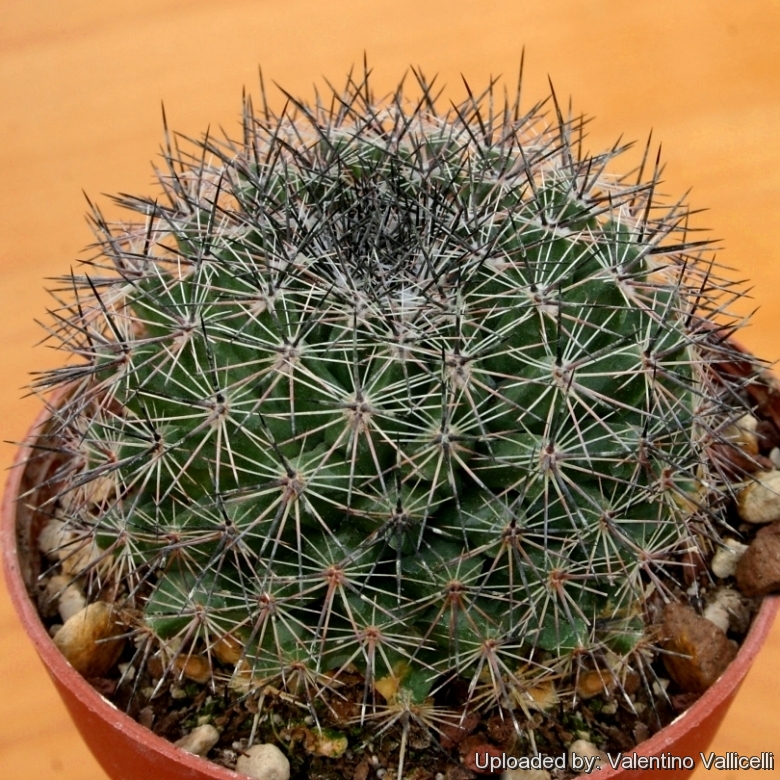Accepted Scientific Name: Mammillaria grusonii C.Runge
Gartenflora xxxviii. (1889) 105. fig. 20. ( "grusoni" )

Mammillaria pachycylindrica Photo by: Valentino Vallicelli
Synonyms:
See all synonyms of Mammillaria grusonii
back
Accepted name in llifle Database:Mammillaria grusonii C.RungeGartenflora xxxviii. (1889) 105. fig. 20. ( "grusoni" )Synonymy: 8
back
Description: Mammillaria pachycylindricaSN|15974]]SN|15977]] is one of the largest species in the genus and usually solitary. It is also known by many to be synonymous with Mammillaria grusoniiSN|15977]]SN|15974]] ,but Reppennhagen considered it a separate form with, darker body, more spines, (20–23 radials and about 6 centrals), different colour of flowers and more cylindrical growth than grusonii.
Habit: It is usually solitary (it has a tendency to remain the same in the culture). It reveals its true beauty only as it becomes 10 or more years old, and reaches 35 cm in height.
Roots: Fibrous.
Stems: Cylindrical, dull green, up to 35 cm tall and 14 cm in diameter.
Tubercles: Pyramidal, terete, basally four-angled, slightly carinate, up to 12 mm tall, 10 mm wide, firm, with latex. The axil is naked or felty.
Areoles: Elliptic, 3 mm long.
Radial spines: 20-23, straight, needle-like, thicker at base, upper ones shorter, 4-8 mm long, at first greyish brown, brown to black with darker tips, later becoming grey.
Central spines: Usually 4 to 7 (but sometime up to 10), straight, stronger than the radial, 8 mm long.
Flowers: Diurnal, bell shaped, dull pink to yellowish brown with a wide brownish-pink midstrip, up to 20 mm long and in diameter.
Blooming season: Spring, and flowers remain open for about three or four days.
Fruits: Scarlet, club shaped, up to25 mm long and 8 mm wide.
Seeds: Brown, club-shaped, 1,2 mm long and 0,6 mm wide. Hilum small and basal.
Subspecies, varieties, forms and cultivars of plants belonging to the Mammillaria grusonii group
- Mammillaria durangicola Repp.: This form has 10-16 radials, 4-15 mm long, 1 - 3 central, 10-17mm long, black, and flowers as in Mammillaria pachycylindrica, with a brownish midstrip.
 Mammillaria grusonii C.Runge: It is one of the largest species in the genus and usually solitary, it reaches 30 cm or more in diameter.
Mammillaria grusonii C.Runge: It is one of the largest species in the genus and usually solitary, it reaches 30 cm or more in diameter.- Mammillaria mexicensis R.T.Craig: has dark pink flowers.
 Mammillaria pachycylindrica Backeb.: (Reppennhagen considered it a separate form) with more spines, 20–23 grayish-white radials and about 6 centrals, at first dark, blackish-brown, becoming gray, tepals lobes with a wide brownish-pink midstrip.
Mammillaria pachycylindrica Backeb.: (Reppennhagen considered it a separate form) with more spines, 20–23 grayish-white radials and about 6 centrals, at first dark, blackish-brown, becoming gray, tepals lobes with a wide brownish-pink midstrip. Mammillaria papasquiarensis (Bravo) Repp.: is a long spined form, with 8-10 radial spines, 5-40 mm long, and 1 to 3 central spines, 40 - 100 mm long. The flowers are white with a pinkish midstrip.
Mammillaria papasquiarensis (Bravo) Repp.: is a long spined form, with 8-10 radial spines, 5-40 mm long, and 1 to 3 central spines, 40 - 100 mm long. The flowers are white with a pinkish midstrip.- Mammillaria tinuvieliae Laferr.
 Mammillaria zeyeriana F.Haage ex K.Schum.: The spines are of intermediate measurement, of which the radials are 10 to 15, 8-15 mm long, and the centrals usually 4 (but sometime up to 6), 12 - 25 mm long. The flowers are similar to those of Mammillaria papasquiarensis.
Mammillaria zeyeriana F.Haage ex K.Schum.: The spines are of intermediate measurement, of which the radials are 10 to 15, 8-15 mm long, and the centrals usually 4 (but sometime up to 6), 12 - 25 mm long. The flowers are similar to those of Mammillaria papasquiarensis.
Bibliography: Major references and further lectures
1) John Borg “Cacti: a gardener's handbook for their identification and cultivation” Blandford P., 1970
2) Nathaniel L. Britton, J. N. Rose “Cactaceae: Descriptions and Illustrations of Plants of the Cactus” Volume IV. The Carnegie Institution of Washington Washington, 24/Dec/1923
3) Edward Anderson “The Cactus family” Timber Press, Incorporated, 2001
4) James Cullen, Sabina G. Knees, H. Suzanne Cubey "The European Garden Flora Flowering Plants: A Manual for the Identification of Plants Cultivated in Europe, Both Out-of-Doors and Under Glass" Cambridge University Press, 11/Aug/2011
5) David R Hunt; Nigel P Taylor; Graham Charles; International Cactaceae Systematics Group. "The New Cactus Lexicon" dh books, 2006
6) John Pilbeam “Mammillaria: the cactus file handbook” Cirio Publishing Services Ltd Dec/30,/1999
Cultivation and Propagation: This plant blooms easily and needs lots of light. Use a pot with good drainage and a very porous mineral-based potting mix. Potted plants are quite wet-sensitive, especially in light of its small root system. Water sparingly during the growing season, let soil dry in between to prevent root rot, keep very dry in winter. Feed with a high potassium fertilizer in summer.
Usually it is recommended to over-winter this plant in a bright and warm greenhouse with at least 8-10° C , but it has proven to be quite frost resistant (if kept dry it is hardy as low as -7° C). A resting period in winter and strong light are necessary so that it can flower properly. Plants will offset readily, and dense clumps can be produced in a very few years.
Propagation: Through seeds and cuttings.











